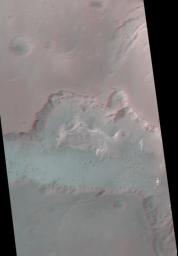
|
Ganges Chasma in 3-D
- Click the image above for a larger view
- Full-Res JPEG (595 x 860) (44.0 kB)
- Full-Res TIFF (595 x 860) (1.1 MB)
Caption:
Ganges Chasma is part of the Valles Marineris trough system that stretches nearly 5,000 kilometers (3,000 miles) across the western equatorial region of Mars. The stereo anaglyph shown here is a composite of two wide angle MOC images taken during Mars Global Surveyor's Geodesy Campaign in May-June 1999. The stereoscopic effect can be seen by viewing the image through red-blue "3-D" glasses. In this map-projected view, north is up and the sun's illumination is from the left.
The center of Ganges Chasma sports a wedding cake-like stack of bright, layered rock. It has been known since the Mariner 9 mission that this bright material is piled nearly as high as the outside rims of the chasm. A smaller outcropping of bright rock is visible toward the lower right. No one yet knows what these layered materials are made of, but speculations over the years have included lake sediments, volcanic ash, and windblown dust. Others have suggested that the bright material is similar to the rock that makes up the walls of the chasm, but that these have been eroded differently or by somewhat different processes.
The smooth floor of Ganges Chasma, particularly in the area south and west of the bright stack of layered material, is a thick, relatively flat sheet of dark, windblown sand. The jumbled troughs and depressions that run from the north side of Ganges Chasma toward the upper right corner of the image were caused by the removal of material beneath the surface, followed by collapse. In other words, these features suggest the presence of a large, partially collapsed cavern beneath the surface north of Ganges Chasma. These features might connect further northward with the Shalbatana Vallis outflow channel, but no one knows for sure. The picture covers an area that is 350 km (217 mi) wide. Ganges Chasma is approximately 3 to 5 kilometers (2-3 miles) deep.
Background Info:
Malin Space Science Systems and the California Institute of Technology built the MOC using spare hardware from the Mars Observer mission. MSSS operates the camera from its facilities in San Diego, CA. The Jet Propulsion Laboratory's Mars Surveyor Operations Project operates the Mars Global Surveyor spacecraft with its industrial partner, Lockheed Martin Astronautics, from facilities in Pasadena, CA and Denver, CO.
Cataloging Keywords:
| Name | Value | Additional Values |
|---|---|---|
| Target | Mars | |
| System | ||
| Target Type | Planet | |
| Mission | Mars Global Surveyor (MGS) | Mariner |
| Instrument Host | Mars Global Surveyor | |
| Host Type | Orbiter | Flyby Spacecraft |
| Instrument | Mars Orbiter Camera (MOC) | |
| Detector | ||
| Extra Keywords | Color, Dust, Map, Volcano | |
| Acquisition Date | ||
| Release Date | 1999-06-25 | |
| Date in Caption | ||
| Image Credit | NASA/JPL/MSSS | |
| Source | photojournal.jpl.nasa.gov/catalog/PIA02065 | |
| Identifier | PIA02065 | |
